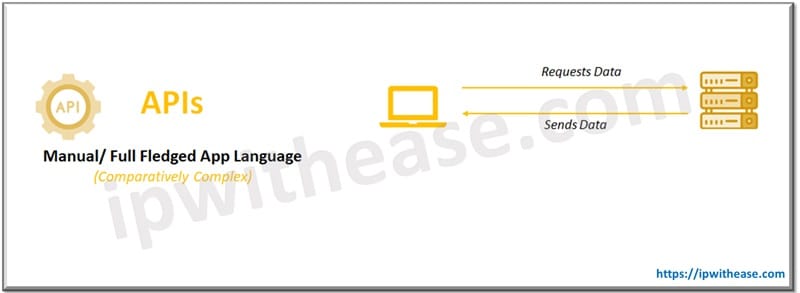Table of Contents
Effective communication of technology has taken a significant precedence in the modern era. Due to demands of business we need to find ways and means to make technologies talk to each other using Webhook and APIs. Both webhook and API enables sync and data relay between two applications. However, both technologies have way of working differently with slightly different purposes.
In today’s article we understand and compare two web communication technologies – Webhook and API, understand their key differences and use cases, their benefits and limitations.
What is a Webhook
Webhook serve as a cornerstone for automation interactions between two applications. They act like virtual messengers to facilitate seamless communication between online accounts of yours. They enable applications to notify another one when a specific event occurs using real time synchronization and data exchange which does not involve additional effort. Webhooks are push based communication technology which helps applications to transform into synchronized performers.

Use Cases for Webhook
- Updating user subscription status in CRM
- Sending automatic reminders for meetings
- Notifying users won owns stock in organization when stock prices drop at specific level
What is an API
Application programming interfaces (APIs) are the cornerstone of connections. APIs are like transformers which allow different software’s components to interact in a standardized manner. They provide a set of rules to interact, simplify complex processes and enable applications, platforms and services so they all can work together seamlessly. They speed up development, enable and empower the innovative side of applications. Crafting a mobile application, enhancements in existing software, new integrations are all can be achieved using an API.

Use Cases for APIs
- Shipment tracking on e-commerce websites
- Traffic data pulling for maps
- Using third party MFA to login into company portal
Related: Types of API Protocols
Comparison: Webhook vs API
Below table summarizes the differences between the two:
| Features | Webhook | API |
| Definition | Webhook is also known as reverse API, web callback and HTTP push API. It delivers data when an event occurs or instantly | API is a software intermediary which let two applications communicate with each other |
| Working | Webhook are event based and work when a specific event happens in source application | APIs are request based and operate when request comes from third party applications |
| Usage | Ideally suited for smaller data and acts as messenger and helps to send and extract updates in real time. Suitable for scenario where application or platform requires real time feature | APIs are well suited when you are constantly requiring incremental changes in data. For example, an e-commerce website has to track data or regularly update shipping status |
| Functioning | Webhook let data to be sent instantly from one application to another. It does not need to send request to server. Data transfer payload happens in JSON or XML format | An API endpoint, URL or access to particular resource or functionality can be made available by webservice. An API endpoint requires request to the server to get response (in structure format such as JSON or XML) |
| Operating Mode | Webhook receive calls via HTTP POST from external system if there are any data updates | APIs place requests without knowing if data update on a request or response |
Download the comparison table: webhook vs api
Benefits of Webhook over APIs
1. Real-Time Updates
- Webhook: Instantly delivers data to your application when an event occurs, providing real-time updates.
- API: Requires periodic requests to check for updates, which introduces latency.
2. Reduced Server Load
- Webhook: Eliminates the need for constant requests by only sending data when an event occurs.
- API: Continuously queries the server, increasing resource consumption.
3. Improved Efficiency
- Webhook: Reduces unnecessary calls to the server, focusing only on relevant events.
- API: May frequently make requests that return no new data, wasting bandwidth and processing power.
4. Lower Costs
- Webhook: By reducing API calls, webhooks lower infrastructure costs, especially in high-traffic systems.
- API: Requires more resources and higher API quotas, increasing costs.
5. Faster Response Times
- Webhook: Events are pushed immediately, enabling quicker responses to user actions.
- API: Response depends on the frequency of polling intervals, which can introduce delays.
6. Simpler Implementation for Real-Time Use
- Webhook: Ideal for scenarios requiring real-time notifications, like payment updates or order tracking.
- API: Requires complex logic to mimic real-time behavior with frequent polling.
7. Scalability
- Webhook: Easily scales with event-driven architectures, as it reacts only to triggered events.
- API: Scalability becomes challenging with increased traffic due to constant polling.
8. Customization and Flexibility
- Webhook: Sends only relevant data for specific events to a predefined endpoint.
- API: Typically requires querying the entire resource repeatedly, even for minor changes.
9. Better for Low-Change Data
- Webhook: Efficient for events that occur sporadically, avoiding the need for continuous checking.
- API: Inefficient for infrequent changes, as it wastes resources.
When to Use APIs Over Webhooks
Considering the list of benefits of webhooks over APIs, an obvious question arises – when to use the APIs?
- For systems requiring on-demand data fetching.
- When the application needs historic data or frequent queries.
ABOUT THE AUTHOR

You can learn more about her on her linkedin profile – Rashmi Bhardwaj



